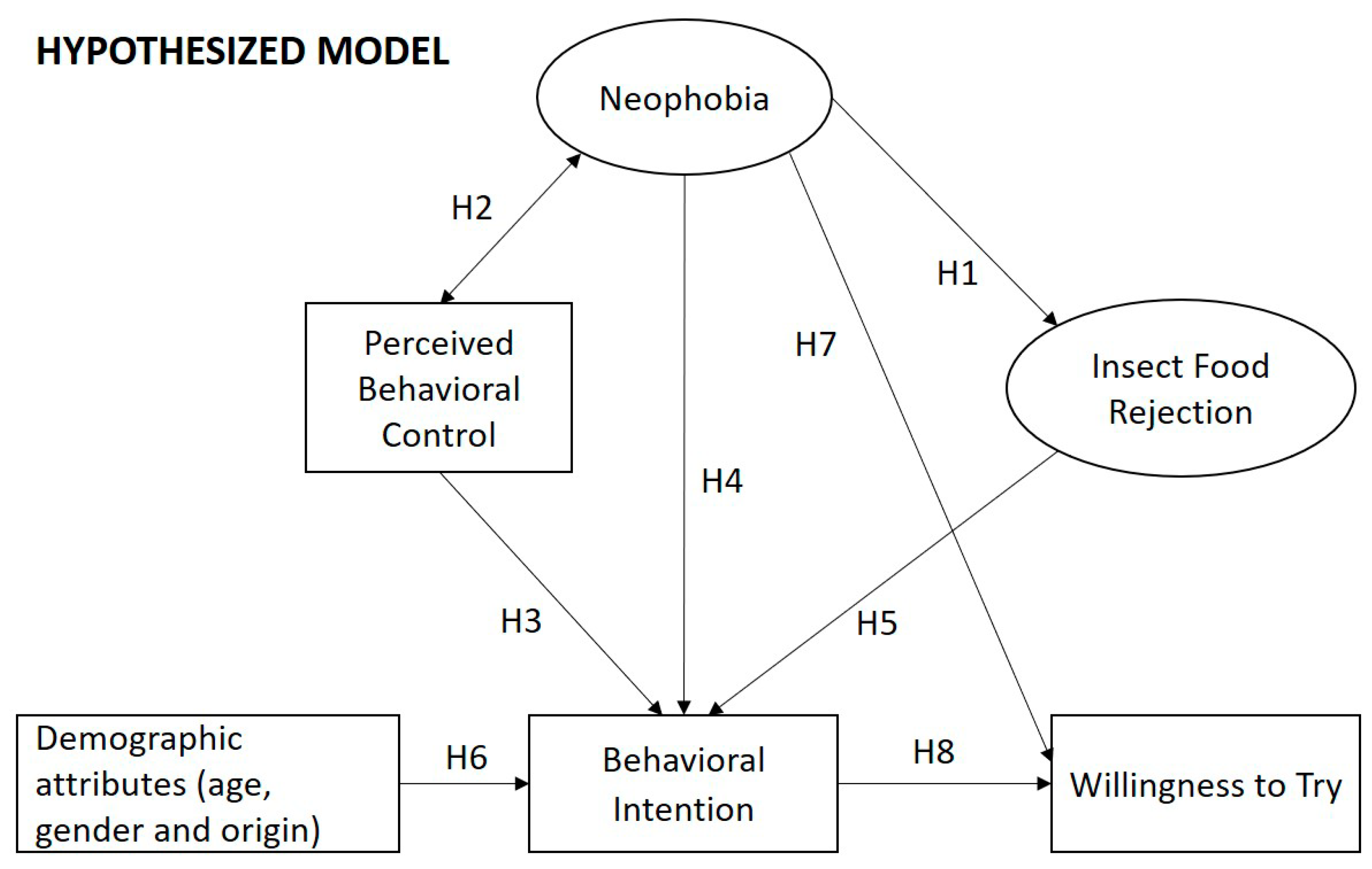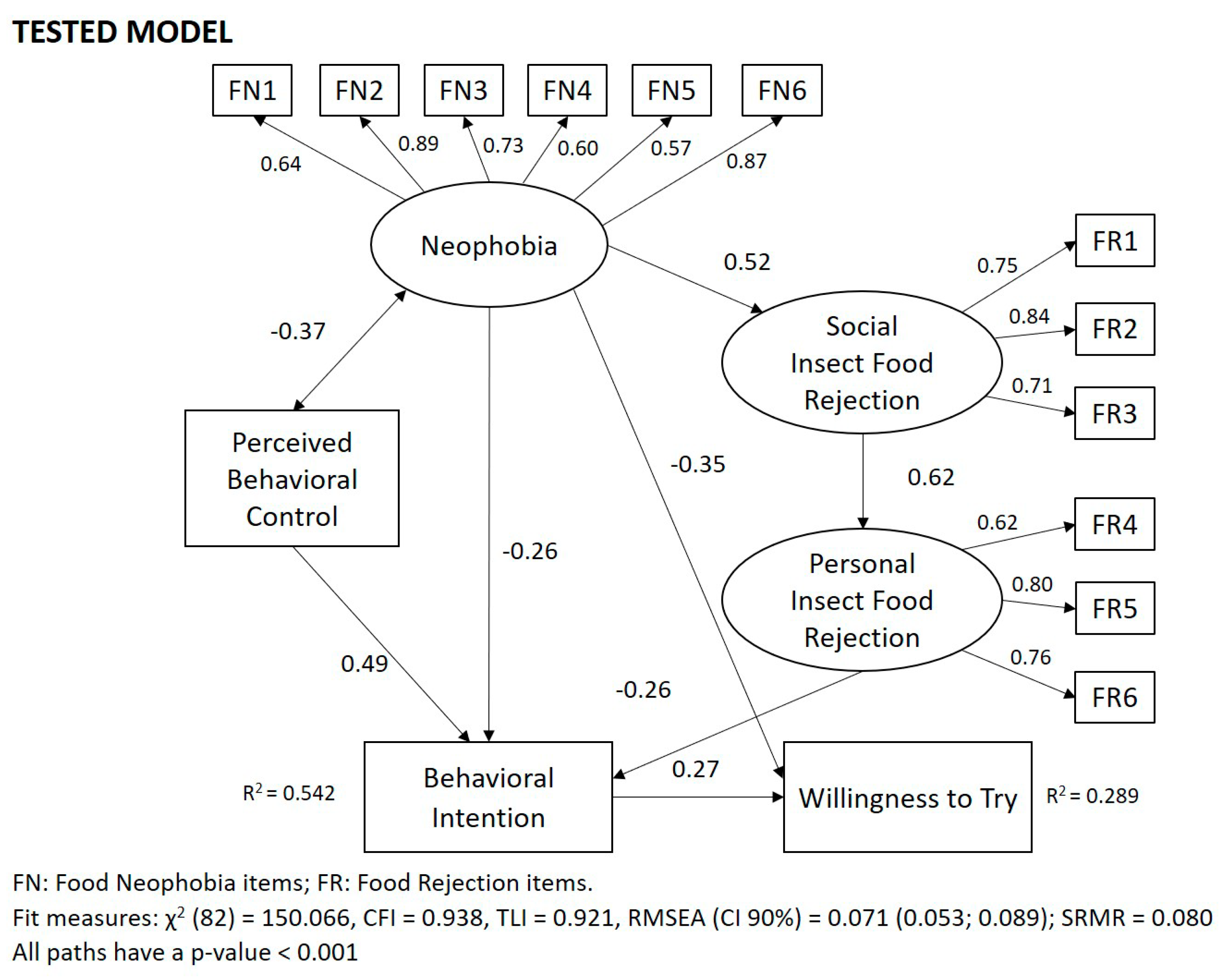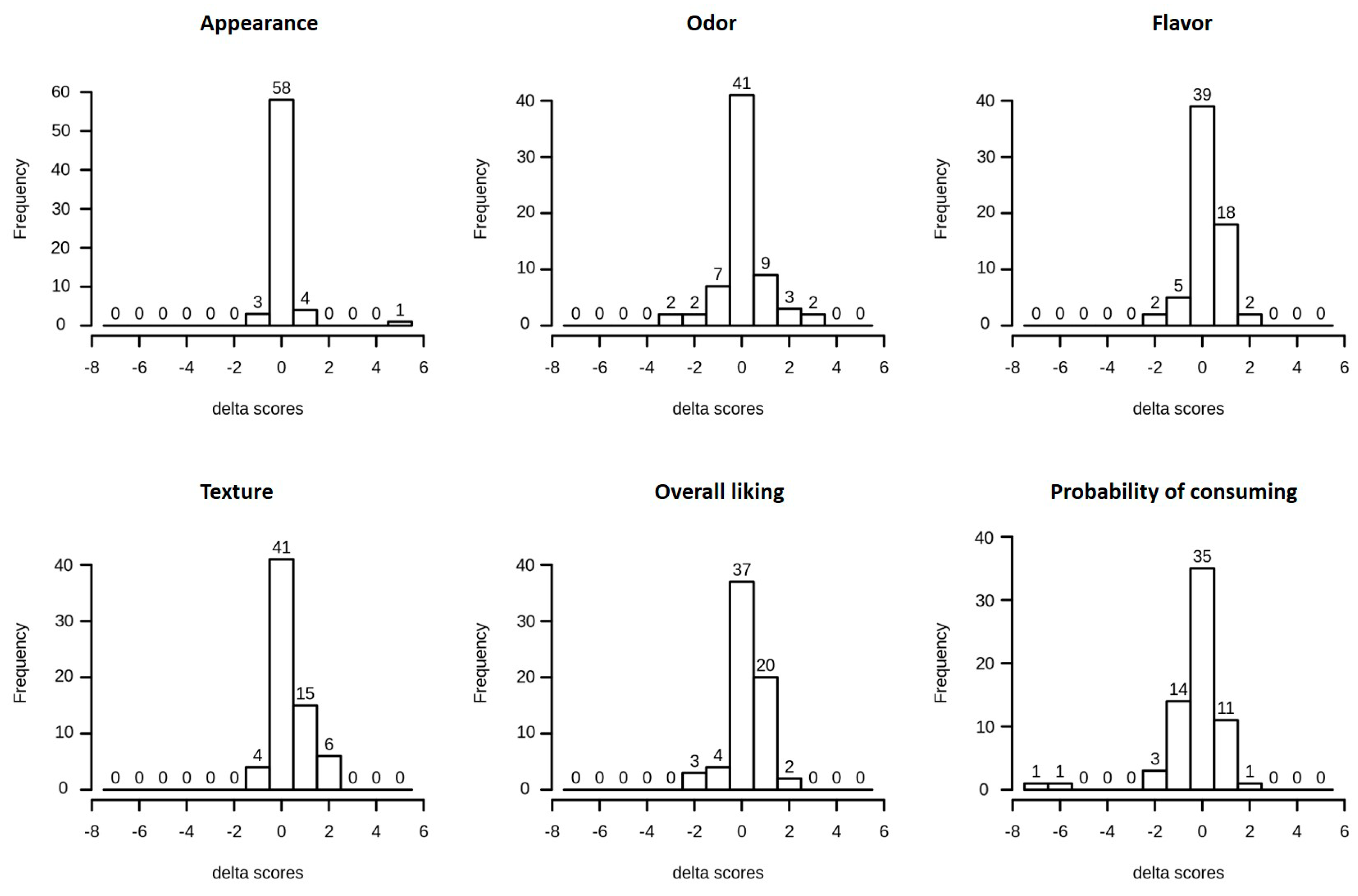Factors Predicting the Intention of Eating an Insect-Based Product
Abstract
1. Introduction
2. Material and Methods
2.1. Theoretical Model
2.2. Participants and Data Collection
2.3. Questionnaire Design and Measures
2.4. Tasting Session
2.5. Statistical Analyses
3. Results
3.1. The Influence of Behavioral Beliefs
3.2. Post-Seminar
3.3. Model Testing and Results
3.4. Tasting Session
4. Discussion
Reactions towards Insects
5. Conclusions
Author Contributions
Funding
Acknowledgments
Conflicts of Interest
References
- Evans, J.; Alemu, M.H.; Flore, R.; Frøst, M.B.; Halloran, A.; Jensen, A.B.; Maciel-Vergara, G.; Meyer-Rochow, V.B.; Münke-Svendsen, C.; Olsen, S.B.; et al. ‘Entomophagy’: An evolving terminology in need of review. J. Insects Food Feed 2015, 1, 293–305. [Google Scholar] [CrossRef]
- van Huis, A.; Van Itterbeeck, J.; Klunder, H.; Mertens, E.; Halloran, A.; Muir, G.; Vantomme, P. Edible Insects. Future Prospects for Food and Feed Security; FAO: Rome, Italy, 2013. [Google Scholar]
- Looy, H.; Dunkel, F.V.; Wood, J.R. How then shall we eat? Insect-eating attitudes and sustainable foodways. Agric. Hum. Values 2014, 31, 131–141. [Google Scholar] [CrossRef]
- Zielińska, E.; Karaś, M.; Baraniak, B. Comparison of functional properties of edible insects and protein preparations thereof. LWT 2018, 91, 168–174. [Google Scholar] [CrossRef]
- Hartmann, C.; Siegrist, M. Consumer perception and behaviour regarding sustainable protein consumption: A systematic review. Trends Food Sci. Technol. 2017, 61, 11–25. [Google Scholar] [CrossRef]
- House, J. Consumer acceptance of insect-based foods in the Netherlands: Academic and commercial implications. Appetite 2016, 107, 47–58. [Google Scholar] [CrossRef] [PubMed]
- Van Thielen, L.; Vermuyten, S.; Storms, B.; Rumpold, B.; Van Campenhout, L. Consumer acceptance of foods containing edible insects in Belgium two years after their introduction to the market. J. Insects Food Feed 2018, 1, 1–10. [Google Scholar] [CrossRef]
- Caparros Megido, R.; Haubruge, É.; Francis, F. Insects, The Next European Foodie Craze? In Edible Insects in Sustainable Food Systems; Halloran, A., Flore, R., Vantomme, P., Roos, N., Eds.; Springer: Cham, Switzerland, 2018; pp. 353–361. [Google Scholar]
- Deroy, O.; Reade, B.; Spence, C. The insectivore’s dilemma, and how to take the West out of it. Food Qual. Prefer. 2015, 44, 44–55. [Google Scholar] [CrossRef]
- Hartmann, C.; Siegrist, M. Development and validation of the Food Disgust Scale. Food Qual. Prefer. 2018, 63, 38–50. [Google Scholar] [CrossRef]
- Mancini, S.; Moruzzo, R.; Riccioli, F.; Paci, G. European consumers’ readiness to adopt insects as food. A review. Food Res. Int. 2019, 122, 661–678. [Google Scholar] [CrossRef]
- Ajzen, I. The theory of planned behavior. Organ. Behav. Hum. Decis. Process. 1991, 50, 179–211. [Google Scholar] [CrossRef]
- Chen, M.-F. Extending the theory of planned behavior model to explain people’s energy savings and carbon reduction behavioral intentions to mitigate climate change in Taiwan–moral obligation matters. J. Clean. Prod. 2016, 112, 1746–1753. [Google Scholar] [CrossRef]
- Ricci, E.C.; Banterle, A.; Stranieri, S. Trust to Go Green: An Exploration of Consumer Intentions for Eco-friendly Convenience Food. Ecol. Econ. 2018, 148, 54–65. [Google Scholar] [CrossRef]
- Menozzi, D.; Sogari, G.; Veneziani, M.; Simoni, E.; Mora, C. Eating novel foods: An application of the Theory of Planned Behaviour to predict the consumption of an insect-based product. Food Qual. Prefer. 2017, 59, 27–34. [Google Scholar] [CrossRef]
- Pambo, K.O.; Okello, J.J.; Mbeche, R.M.; Kinyuru, J.N.; Alemu, M.H. The role of product information on consumer sensory evaluation, expectations, experiences and emotions of cricket-flour-containing buns. Food Res. Int. 2018, 106, 532–541. [Google Scholar] [CrossRef]
- Armitage, C.J.; Conner, M. Efficacy of the Theory of Planned Behaviour: A meta-analytic review. Br. J. Soc. Psychol. 2001, 40, 471–499. [Google Scholar] [CrossRef]
- Dovey, T.M.; Staples, P.A.; Gibson, E.L.; Halford, J.C.G. Food neophobia and ‘picky/fussy’ eating in children: A review. Appetite 2008, 50, 181–193. [Google Scholar] [CrossRef]
- Pliner, P.; Hobden, K. Development of a scale to measure the trait of food neophobia in humans. Appetite 1992, 19, 105–120. [Google Scholar] [CrossRef]
- Caparros Megido, R.; Gierts, C.; Blecker, C.; Brostaux, Y.; Haubruge, É.; Alabi, T.; Francis, F. Consumer acceptance of insect-based alternative meat products in Western countries. Food Qual. Prefer. 2016, 52, 237–243. [Google Scholar] [CrossRef]
- Sogari, G.; Menozzi, D.; Mora, C. The food neophobia scale and young adults’ intention to eat insect products. Int. J. Consum. Stud. 2019, 43, 68–76. [Google Scholar] [CrossRef]
- Verbeke, W. Profiling consumers who are ready to adopt insects as a meat substitute in a Western society. Food Qual. Prefer. 2015, 39, 147–155. [Google Scholar] [CrossRef]
- Hartmann, C.; Shi, J.; Giusto, A.; Siegrist, M. The psychology of eating insects: A cross-cultural comparison between Germany and China. Food Qual. Prefer. 2015, 44, 148–156. [Google Scholar] [CrossRef]
- Hartmann, C.; Siegrist, M. Becoming an insectivore: Results of an experiment. Food Qual. Prefer. 2016, 51, 118–122. [Google Scholar] [CrossRef]
- Verneau, F.; La Barbera, F.; Kolle, S.; Amato, M.; Del Giudice, T.; Grunert, K. The effect of communication and implicit associations on consuming insects: An experiment in Denmark and Italy. Appetite 2016, 106, 30–36. [Google Scholar] [CrossRef]
- Rozin, P.; Fallon, A. The psychological categorization of foods and non-foods: A preliminary taxonomy of food rejections. Appetite 1980, 1, 193–201. [Google Scholar] [CrossRef]
- Cavallo, C.; Materia, V.C. Insects or not insects? Dilemmas or attraction for young generations: A case in Italy. Int. J. Food Syst. Dyn. 2018, 9, 226–239. [Google Scholar]
- Laureati, M.; Bertoli, S.; Bergamaschi, V.; Leone, A.; Lewandowski, L.; Giussani, B.; Battezzati, A.; Pagliarini, E. Food neophobia and liking for fruits and vegetables are not related to Italian children’s overweight. Food Qual. Prefer. 2015, 40, 125–131. [Google Scholar] [CrossRef]
- Woolf, E.; Zhu, Y.; Emory, K.; Zhao, J.; Liu, C. Willingness to consume insect-containing foods: A survey in the United States. LWT 2019, 102, 100–105. [Google Scholar] [CrossRef]
- Laureati, M.; Proserpio, C.; Jucker, C.; Savoldelli, S. New sustainable protein sources: consumers’ willingness to adopt insects as feed and food. Ital. J. Food Sci. 2016, 28, 652–668. [Google Scholar]
- Laureati, M.; Jabes, D.; Russo, V.; Pagliarini, E. Sustainability and organic production: How information influences consumer’s expectation and preference for yogurt. Food Qual. Prefer. 2013, 30, 1–8. [Google Scholar] [CrossRef]
- Lobb, A.E.; Mazzocchi, M.; Traill, W.B. Modelling risk perception and trust in food safety information within the theory of planned behaviour. Food Qual. Prefer. 2007, 18, 384–395. [Google Scholar] [CrossRef]
- Waldman, K.B.; Kerr, J.M. Does safety information influence consumers’ preferences for controversial food products? Food Qual. Prefer. 2018, 64, 56–65. [Google Scholar] [CrossRef]
- Sogari, G.; Menozzi, D.; Mora, C. Exploring young foodies׳ knowledge and attitude regarding entomophagy: A qualitative study in Italy. Int. J. Gastron. Food Sci. 2017, 7, 16–19. [Google Scholar] [CrossRef]
- Barsics, F.; Caparros Megido, R.; Brostaux, Y.; Barsics, C.; Blecker, C.; Haubruge, E.; Francis, F. Could new information influence attitudes to foods supplemented with edible insects? Br. Food J. 2017, 119, 2027–2039. [Google Scholar] [CrossRef]
- Spence, C. On the psychological impact of food colour. Flavour 2015, 4, 21. [Google Scholar] [CrossRef]
- Byrne, B.M. Structural Equation Modeling with AMOS: Basic Concepts, Applications and Programming; Routledge/Taylor & Francis Group: New York, NY, USA, 2010. [Google Scholar]
- Hu, L.; Bentler, P.M. Cutoff criteria for fit indexes in covariance structure analysis: Conventional criteria versus new alternatives. Struct. Equ. Model. A Multidiscip. J. 1999, 6, 1–55. [Google Scholar] [CrossRef]
- Kline, R.B. Principles and Practice of Structural Equation Modeling; Little, T.D., Ed.; The Guilford Press: New York, NY, USA, 2011. [Google Scholar]
- Lombardi, A.; Vecchio, R.; Borrello, M.; Caracciolo, F.; Cembalo, L. Willingness to pay for insect-based food: The role of information and carrier. Food Qual. Prefer. 2019, 72, 177–187. [Google Scholar] [CrossRef]
- Lensvelt, E.J.S.; Steenbekkers, L.P.A. Exploring Consumer Acceptance of Entomophagy: A Survey and Experiment in Australia and the Netherlands. Ecol. Food Nutr. 2014, 53, 543–561. [Google Scholar] [CrossRef]
- Berger, S.; Bärtsch, C.; Schmidt, C.; Christandl, F.; Wyss, A.M. When Utilitarian Claims Backfire: Advertising Content and the Uptake of Insects as Food. Front. Nutr. 2018, 5, 88. [Google Scholar] [CrossRef]
- Shelomi, M. Why we still don’t eat insects: Assessing entomophagy promotion through a diffusion of innovations framework. Trends Food Sci. Technol. 2015, 45, 311–318. [Google Scholar] [CrossRef]
- Sogari, G. Entomophagy and Italian consumers: An exploratory analysis. Prog. Nutr. 2015, 17, 311–316. [Google Scholar]
- Balzan, S.; Fasolato, L.; Maniero, S.; Novelli, E. Edible insects and young adults in a north-east Italian city an exploratory study. Br. Food J. 2016, 118, 318–326. [Google Scholar] [CrossRef]
- Tan, H.S.G.; Fischer, A.R.H.; Tinchan, P.; Stieger, M.; Steenbekkers, L.P.A.; van Trijp, H.C.M. Insects as food: Exploring cultural exposure and individual experience as determinants of acceptance. Food Qual. Prefer. 2015, 42, 78–89. [Google Scholar] [CrossRef]
- Tan, H.S.G.; Verbaan, Y.T.; Stieger, M. How will better products improve the sensory-liking and willingness to buy insect-based foods? Food Res. Int. 2017, 92, 95–105. [Google Scholar] [CrossRef]
- Schouteten, J.J.; De Steur, H.; De Pelsmaeker, S.; Lagast, S.; Juvinal, J.G.; De Bourdeaudhuij, I.; Verbeke, W.; Gellynck, X. Emotional and sensory profiling of insect-, plant- and meat-based burgers under blind, expected and informed conditions. Food Qual. Prefer. 2016, 52, 27–31. [Google Scholar] [CrossRef]
- Sogari, G.; Menozzi, D.; Mora, C. Sensory-liking expectations and perceptions of processed and unprocessed insect products. Int. J. Food Syst. Dyn. 2018, 9, 314–320. [Google Scholar]
- Tao, J.; Davidov-Pardo, G.; Burns-Whitmore, B.; Cullen, E.M.; Li, Y.O. Effects of edible insect ingredients on the physicochemical and sensory properties of extruded rice products. J. Insects Food Feed 2017, 3, 263–278. [Google Scholar] [CrossRef]



| Items | Total Sample | Male | Female | p | ||||
|---|---|---|---|---|---|---|---|---|
| WTT | No WTT | WTT | No WTT | WTT | No WTT | Gender | WTT | |
| Eating products that contain insect powder will have positive effects on my health | 4.29 (0.88) | 4.18 (0.93) | 4.53 (1.06) | 4.36 (1.79) | 4.24 (0.85) | 4.14 (0.91) | 0.177 | 0.426 |
| Eating products containing insect powder will have positive effect on the environment | 5.65 (1.13) | 5.63 (1.16) | 5.63 (1.31) | 5.55 (1.03) | 5.66 (1.10) | 5.65 (1.16) | 0.801 | 0.901 |
| Eating products containing insect powder will have a taste familiar to products that I already know | 4.39 (1.11) | 3.97 (1.21) | 4.38 (0.88) | 3.73 (1.00) | 4.39 (1.16) | 4.02 (1.25) | 0.604 | 0.028 |
| Items | Before, Mean (sd) | After, Mean (sd) | Mean Difference | 95% CI | p |
|---|---|---|---|---|---|
| The idea of eating insects provokes my disgust | 4.80 (1.83) | 4.09 (1.79) | 0.71 | (0.461, 0.957) | 0.000 |
| I fear that insect-based foods have negative texture properties | 4.61 (1.7) | 4.19 (1.61) | 0.42 | (0.184, 0.653) | 0.001 |
| I fear that insect-based foods have negative taste properties | 3.99 (1.55) | 3.84 (1.59) | 0.15 | (−0.062, 0.365) | 0.164 |
| I believe that insect-based food implies a poor hygiene | 3.30 (1.62) | 2.99 (1.6) | 0.31 | (0.065, 0.542) | 0.013 |
| I believe that eating insects is not part of our diet | 2.91 (1.66) | 2.55 (1.44) | 0.36 | (0.152, 0.575) | 0.001 |
| Eating insects is not socially acceptable | 2.52 (1.43) | 2.27 (1.38) | 0.25 | (0.042, 0.467) | 0.019 |
| Items | Cronbach’s Alpha | Factor Loadings | |
|---|---|---|---|
| Food Neophobia | 0.862 | ||
| FN1 | I am constantly sampling new and different foods (R) | 0.613 | |
| FN2 | I like foods from different cultures (R) | 0.909 | |
| FN3 | Ethnic food looks too weird to eat | 0.719 | |
| FN4 | At dinner parties, I will try new foods (R) | 0.568 | |
| FN5 | I am afraid to eat things I have never had before | 0.579 | |
| FN6 | I like to try new ethnic restaurants (R) | 0.874 | |
| Items | Cronbach’s Alpha | Factor Loadings | |
|---|---|---|---|
| Social Insect Food Rejection | 0.81 | ||
| FR1 | I believe that insect-based food implies a poor hygiene | 0.75 | |
| FR2 | I believe that eating insects is not part of our diet | 0.872 | |
| FR3 | Eating insects is not socially acceptable | 0.684 | |
| Personal Insect Food Rejection | 0.758 | ||
| FR4 | The idea of eating insects provokes my disgust | 0.59 | |
| FR5 | I fear that insect-based foods have negative texture properties | 0.816 | |
| FR6 | I fear that insect-based foods have negative taste properties | 0.776 | |
| Items | “control” Sample | “insect labelled” Sample | p |
|---|---|---|---|
| Appearance | 7.2 (1.32) | 7.29 (1.19) | 0.407 |
| Odor | 6.64 (1.74) | 6.7 (1.53) | 0.626 |
| Flavor | 7.06 (1.12) | 7.26 (1.14) | 0.044 |
| Texture | 6.77 (1.38) | 7.12 (1.42) | <0.001 |
| Overall liking | 7.18 (1.14) | 7.39 (1.09) | 0.045 |
| Probability of consuming | 7.52 (1.51) | 7.21 (1.67) | 0.107 |
© 2019 by the authors. Licensee MDPI, Basel, Switzerland. This article is an open access article distributed under the terms and conditions of the Creative Commons Attribution (CC BY) license (http://creativecommons.org/licenses/by/4.0/).
Share and Cite
Mancini, S.; Sogari, G.; Menozzi, D.; Nuvoloni, R.; Torracca, B.; Moruzzo, R.; Paci, G. Factors Predicting the Intention of Eating an Insect-Based Product. Foods 2019, 8, 270. https://doi.org/10.3390/foods8070270
Mancini S, Sogari G, Menozzi D, Nuvoloni R, Torracca B, Moruzzo R, Paci G. Factors Predicting the Intention of Eating an Insect-Based Product. Foods. 2019; 8(7):270. https://doi.org/10.3390/foods8070270
Chicago/Turabian StyleMancini, Simone, Giovanni Sogari, Davide Menozzi, Roberta Nuvoloni, Beatrice Torracca, Roberta Moruzzo, and Gisella Paci. 2019. "Factors Predicting the Intention of Eating an Insect-Based Product" Foods 8, no. 7: 270. https://doi.org/10.3390/foods8070270
APA StyleMancini, S., Sogari, G., Menozzi, D., Nuvoloni, R., Torracca, B., Moruzzo, R., & Paci, G. (2019). Factors Predicting the Intention of Eating an Insect-Based Product. Foods, 8(7), 270. https://doi.org/10.3390/foods8070270








